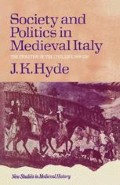Abstract
While it was the economic revival that provided the driving force, the direction taken by Italian society was strongly influenced by the political conditions of the time. Throughout the peninsula during the eleventh century, the time-honoured imperial system of government — Byzantine in the south, German in the north — passed through a time of strain and weakness, ending in virtual collapse which handed the initiative to local forces. In the south the breakdown of the central government was relatively short-lived and a powerful Norman kingdom built upon Byzantine and Arab foundations emerged; in the north, on the other hand, the attempts to revive imperial power all ended in failure and local particularism triumphed all but completely. It was in this region, stretching from Rome to the Alps, that the characteristic Italian society of the Middle Ages was free to evolve most fully; here the communes became in effect city-states, so that the area may be conveniently described as communal Italy.
Access this chapter
Tax calculation will be finalised at checkout
Purchases are for personal use only
Preview
Unable to display preview. Download preview PDF.
References
See above, pp. 21–2.
A. Solmi, L’amministrazione finanziaria del regno italico (Pavia 1932), 187 ff.
Guibert de Nogent, De vita sua iii, 8, trans. J. F. Benton, Self and Society in Medieval France (New York 1970), 174.
Muratori, Antiquitates iv, 19.
‘Carmen in victoriam Pisanorum’, in E. Du Méril, Poésies Populaires Latines au Moyen-Age (Paris 1847), 239–51.
Liber Maiolichinus de Gestis Pisanorum Illustribus ed. C. Calisse, FSI, 28 (Rome 1904).
CDG, i n. 8.
CDG, i nn. 128, 285.
L. Savioli, Annali bolognesi, 1, ii (Bassano 1784), rm. 96, tog; A. Hessel, Geschichte der Stadt Bologna (Berlin Ig1o), 51–85; L. Simeoni, ‘Bologna e la politica italiana di Enrico V’, Atti e Memorie Dep. Storia Patria per l’Emilia e la Romagna, ns. ii (1937), 147–66.
For example, in 1211 the Modenese council met in the bishop’s tent outside the castle of Bazzano (Savioli, op. cit. n. 397).
C. Manaresi, Gli atti del comune di Milano (Milan 1919), n. iii; Jaffe, Regesta Pontificum nn. 5354–6.
F. Bonaini, Statuti inediti della cittd di Pisa (Florence 1854–7), i, 16–18.
Ibid. i 18–19.
Libellus de Situ Civitatus Mediolani ed. G. and A. Colombo, RIS, 1, 2 (1942); Mutinensis Urbis Descriptio RIS, II, ii (old edn), 687–92.
Plate II. G. Fasoli, Dalla civitas al comune 157–8, suggests that this sculpture represents the peace between the milites and the citizens from which the commune was born. This is an attractive idea, but it must be regarded as not proven, since there is no firm evidence that the knights and citizens formed separate bodies at Verona at this period, though they did in contemporary Milan. All one can say with certainty is that the bishop is presenting only one standard, and he is giving it to the populus which must signify the whole active membership of the newly formed commune.
See C. B. Fisher, ‘The Pisan Clergy and an Awakening of Historical Interest in an Italian Commune’, Studies in Medieval and Renaissance History(1966), 141–219.
G. Cremaschi, Mosè del Brolo e la cultura a Bergamo nei secoli XI e XII (Bergamo 1945 ).
Edited many times, e.g. R. Valentini and G. Zucchetti, Codice topografico della citta di Roma FSI (1940–6), iii, 1–65.
P. Jaffé, Biblioteca Rerum Germanicarum (Berlin 1864–9), 1, 539–43.
Copyright information
© 1973 J. K. Hyde
About this chapter
Cite this chapter
Hyde, J.K. (1973). The Emergence of the Communes. In: Society and Politics in Medieval Italy. New Studies in Medieval History. Palgrave, London. https://doi.org/10.1007/978-1-349-15504-0_3
Download citation
DOI: https://doi.org/10.1007/978-1-349-15504-0_3
Publisher Name: Palgrave, London
Print ISBN: 978-0-333-11460-5
Online ISBN: 978-1-349-15504-0
eBook Packages: Palgrave History CollectionHistory (R0)

